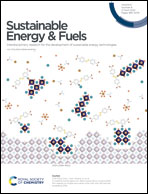A flexible self-poled piezocomposite nanogenerator based on H2(Zr0.1Ti0.9)3O7 nanowires and polylactic acid biopolymer†
Abstract
The field of piezoelectric nanogenerators is rapidly growing as a promising technology for driving low-power portable devices and self-powered electronic systems by converting wasted mechanical energy into electric energy. In this study, we designed a flexible and self-poled piezocomposite nanogenerator based on lead-free H2(Zr0.1Ti0.9)3O7 (HZTO) nanowires and a polylactic acid (PLA) biodegradable polymer. By using a piezoresponse force microscope (PFM), the piezoelectric coefficient (d33) of a single HZTO nanowire was found to be 26 pm V−1. The piezoelectric energy harvesting performances of a self-poled piezocomposite film fabricated by embedding core–shell structured HZTO nanowires by polydopamine into the PLA matrix were tested. The piezoelectric nanogenerator demonstrated enhanced output performances (an open-circuit voltage of 5.41 V, short-circuit current of 0.26 μA and maximum power density of 463.5 μW cm−3 at a low resistive load of 2.5 MΩ). Besides, the developed device can charge different capacitors by regular mechanical impartations and can power a red light-emitting LED diode by various biomechanical motions. This study reveals the benefits of combining HZTO nanowires and PLA biopolymer in designing high-performance piezoelectric nanocomposites for biomechanical energy harvesting.



 Please wait while we load your content...
Please wait while we load your content...